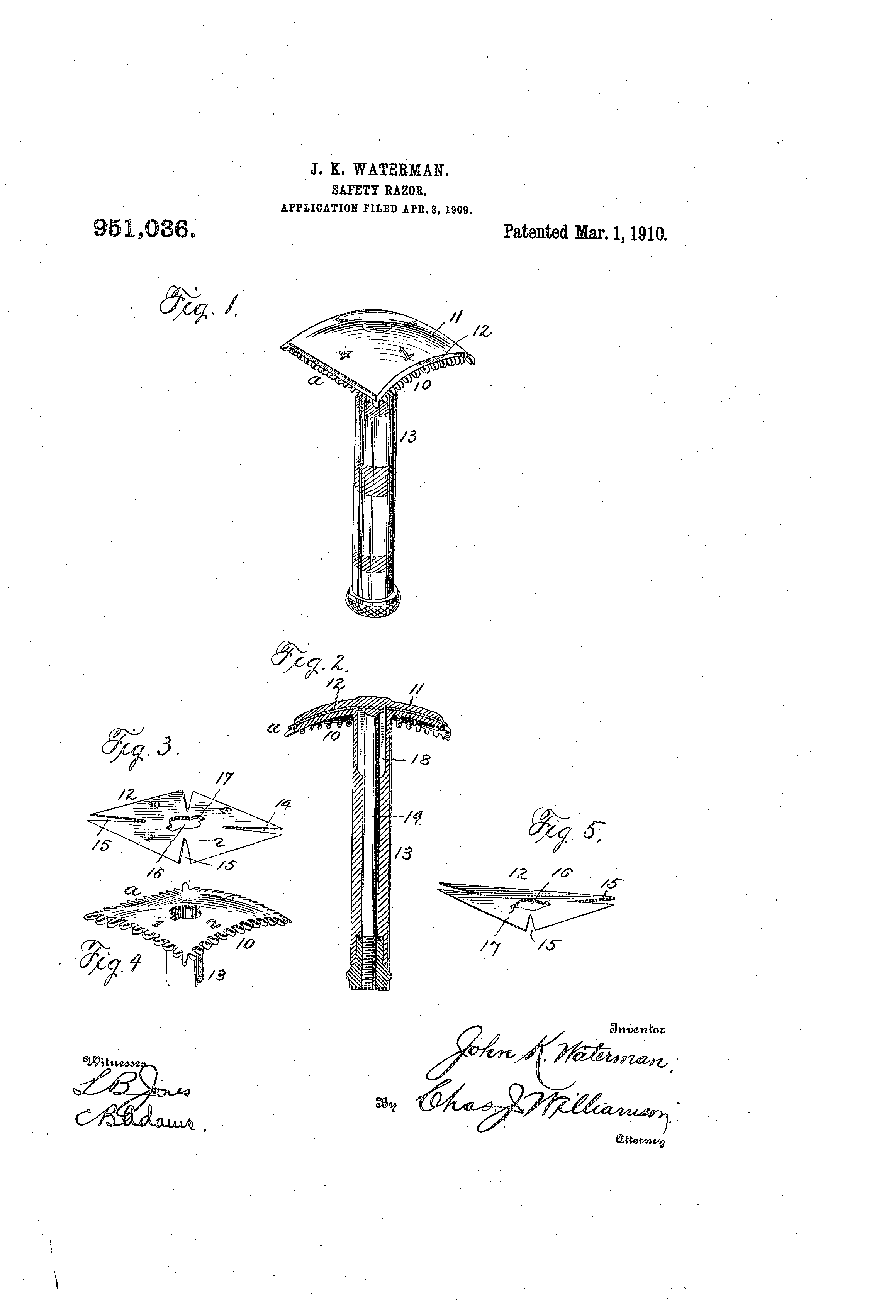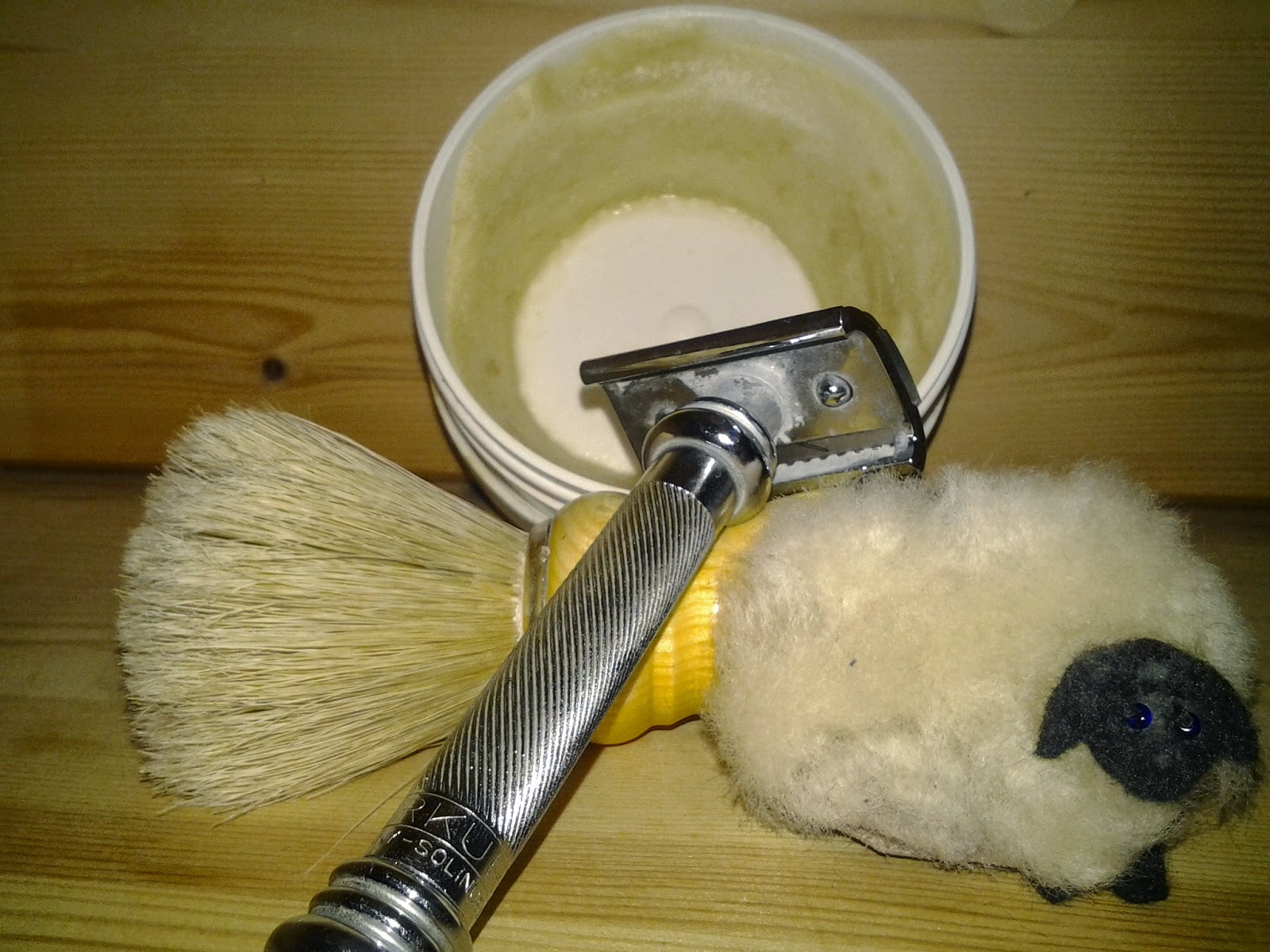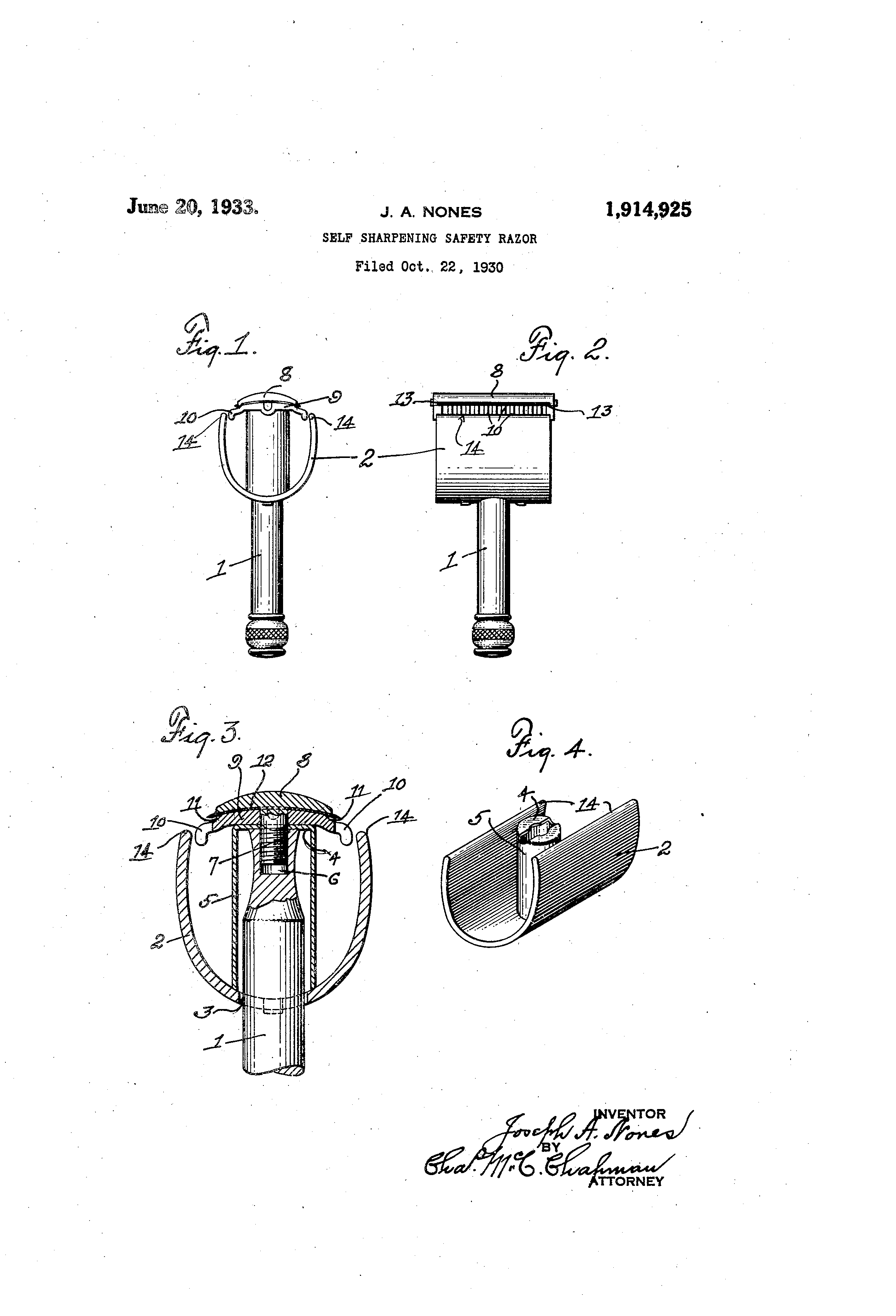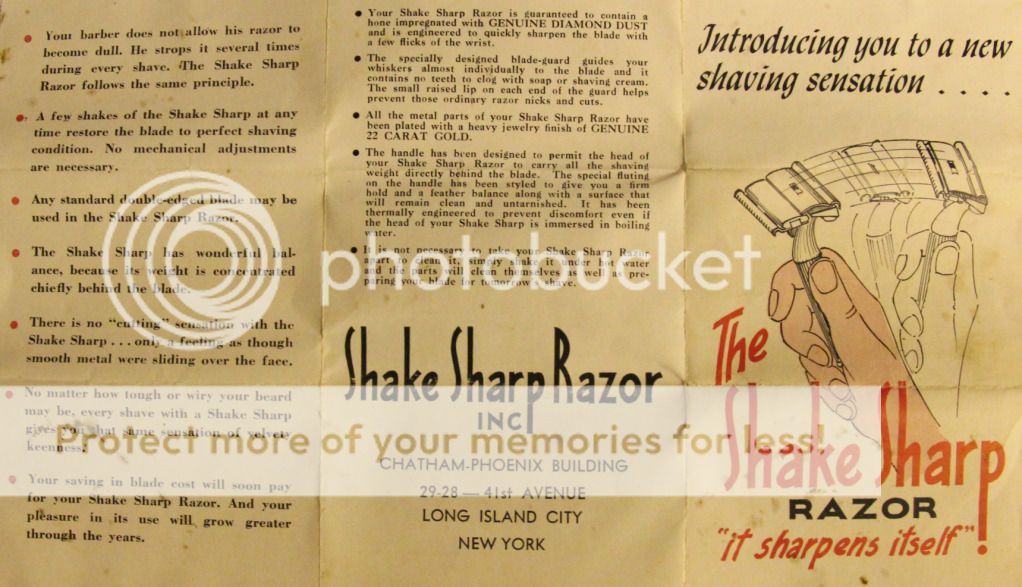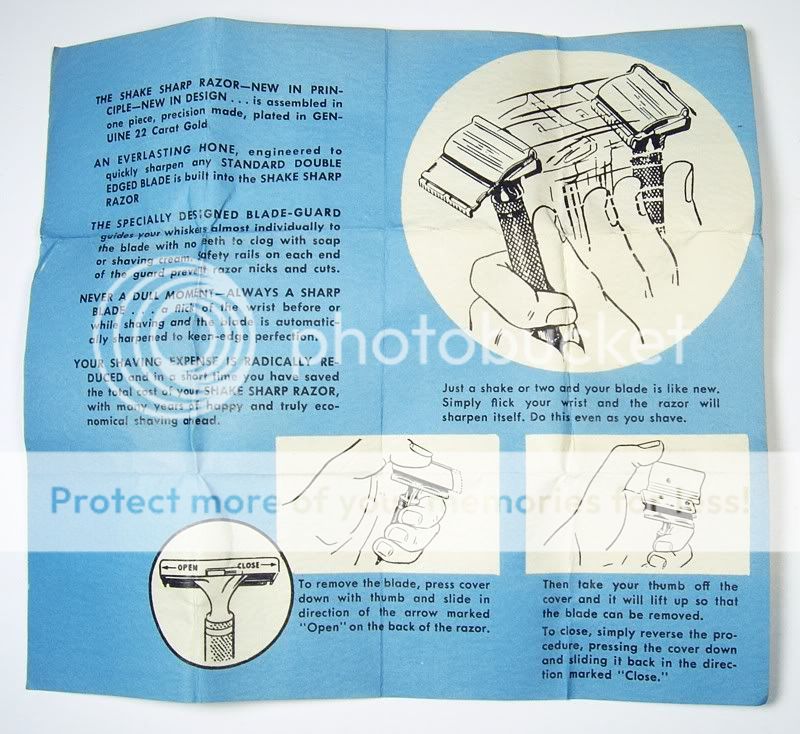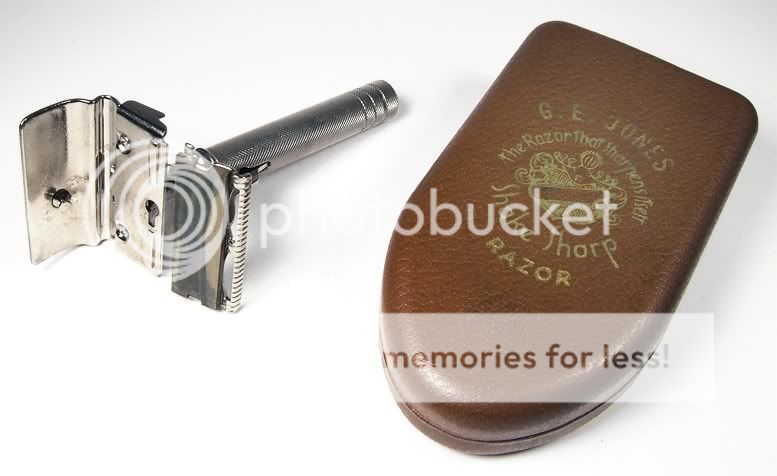Pre-shave: Dr Bronner’s Liquid Orange
Lather: Mike’s Natural Orange, Pepper & Cedarwood Shave Stick
Brush: Semogue TSN 2012 LE mixed badger/boar
Razor: (Probably) Merkur Bakelite slant with a Treet Platinum blade
Post-shave: Cool water rinse, alum, and Krampert’s Finest Bay Rum
Monthly Archives: November 2014
Quad Edge razor – when Double Edge isn’t enough
More is better, right? And before we had razors with multiple blades, we had razor blades with multiple edges… and if two edges (DE) is good, then three or four edges must be better!
I suspect that was the line of logic Mr J K Waterman followed in 1909 when he applied for a US patent. In is own words, the object of his invention was to provide to the public:
…a safety razor which will be adaptable to all portions of the face, and which will have a great extent of cutting edge, and withal will’ be simple of construction and convenient of manipulation in assembling and separating its parts…
The actual design don’t look too bad, even if getting the curvature right on the head must have been tricky – a regular DE is a two dimensional curve (yes, even a slant), whereas Mr Waterman’s invention required a head curved in three dimensions.
The sticking point with this razor is the blades though… as can be seen in the drawing, they have the shape of a Maltese cross, and would be much costlier and more difficult to manufacture than regular DE blades. Shame really, because the idea of four edges is oddly tempting.
Shave of the day 12th November
Pre-shave: Dr Bronner’s Liquid Lavender
Lather: MIke’s Natural Coconut (sample)
Brush: Vie Long 14033 mixed horse/badger
Razor: (Probably) Merkur Bakelite slant with a Treet Platinum blade
Post-shave: Cool water rinse, alum, and Proraso Liquid After Shave Cream
Reasons for cuts while shaving
Shaving made easy is a book from 1904 that I have mentioned before on my blog.. it’s an interesting read and it’s free (as in beer), so why not download it and give it a read? Even if it’s 110 years since the book was printed, the advice given is just as valid.
![]()
On my latest read through of it, I spotted the following sage advice:
If a man cuts himself while shaving, it is usually due to certain causes that are easily avoidable. The principal causes are six in number:
- First—Attempting to shave with a dull razor.
- Second—Using a sharp pointed razor.
- Third—Shaving with a razor that is too hollow ground, so that the edge springs and bends on the face.
- Fourth—Holding the razor improperly.
- Fifth—Shaving upward against the growth of the beard.
- Sixth—Shaving in too great a hurry.
If you will avoid these mistakes and exercise proper care, you will seldom cut yourself. But when you do, it will be well to know how to treat the wound. If it be slight, the bleeding may sometimes be checked by using pressure. Covering the fingers with a towel, simply press the cut together. If this does not stop the flow, use an astringent. The styptic pencils, made especially for this purpose, are the best, and may be obtained at any store where barbers’ supplies are kept. In case you should not have the pencils, alum may be used. In any event do not be discouraged, for such accidents sometimes happen to the best barbers.
I suspect the second and third reasons don’t quite apply to those of us using a DE or SE, but the other four holds true.
Shave of the day 10th November
Shave of the day 7th November
Pseudo-scientific razor
Magnets, how do they work? Apparently well enough to sharpen razor blades…
Mr J A Nones was granted a patent for a self sharpening razor in 1933 that employed the power of magnets to keep the blade sharp and the razor head clunky…
In the inventors own words from the patent description:
…a safety razor with means for automatically sharpening or readjusting the minute particles of the functional or executive edges of the blade…
… a safety razor of the type noted with a magnetic means by which the edges of the wafer-blade may be reconditioned or sharpened…
According to my invention, the extremities of the pole portions of the magnet are inwardly curved toward the guard fingers 10 and terminate midway the length of the downwardly extending portions of said fingers; and said terminal portions or poles of the magnet are spaced apart from but are close to the line of guard fingers from end-to-end of the razor. The pole terminals of the magnet are also arranged sufficiently close to the cutting edges of the razor blade to exercise the necessary magnetic attraction for the minute deflected portions, produced during the course of shaving or while the blade is in use. It is this forceful attraction which reconditions the edges of the blade and sharpens the same, and restores the so-called teeth of said razor blade’edges to the normal plane of the blade-body.
It is my belief that the huge success of Mr Nones’ razor in the marked place clearly shows how effective magnets are for keeping your razorblades sharp. If you put this invention in a pyramid – which as we all know keeps milk fresh and razors sharp – it is quite possible you’ll end up going back in time… or just look like a fool.
Shave of the day 5th November
Pre-shave: Dr Bronner’s Liquid Peppermint
Lather: Arko shave stick
Brush: BodyShop synthetic
Razor: Merkur 37C slant with a Wilkinson blade
Post-shave: Cool water rinse, alum, and BodyShop Maca Root Face Protector
Shake it sharp!
Yet another razor oddity I have dug up some information on, courtesy of a chance remark over on my favourite shave forum: the Shape Sharp Razor!
The basic idea is interesting, and ties into the razor blade sharpeners I blogged about last month: Keep your razor blades sharp, and keep them longer. Made a lot more sense of the old carbon blades than it do for modern stainless ones, since they cost more (relatively speaking) and dulled quicker.
At a glance, it looks like a SE razor with a wicked blade exposure and an oversized head… but there is a reason for that: the head contains a hone, and holds a regular DE blade. The idea is/was that the user shake the razor back and forth to keep the edge honed during shaving, thus having a perfectly honed blade at all time for the best possible shave… at least, that is what the pamphlet says.
According to the information I found online, the construction is a combination of cast zinc and stamped brass, and possibly steel – although I’ve also spotted references to Shake Sharps with bakelite handles.
Since only one edge was exposed at any given time, the shaver had to open the razor and flip the blade around when he wanted to use the second edge. If the honing feature worked – and I have no reason to believe otherwise after looking at the patents online – you would only have to do that after wearing one edge out completely.


